Sickle cell anaemia, sometimes called sickle cell disease, is a condition in which the normally flexible and round red blood cells are sticky, rigid, and shaped like a tiny sickle or crescent. These oddly-shaped red blood cells can stick to the walls of blood vessels causing pain and blockages. Although sickle cell disease is generally diagnosed in childhood, there is no cure and treatment is lifelong.
What causes it?
Sickle cell anaemia is an inherited condition.
Is it serious?
Yes. People with sickle cell anaemia are at a higher risk for stroke, hypertension (high blood pressure), organ damage, blindness, skin ulcers, and gallstones.
Can I prevent sickle cell anaemia?
Sickle cell anaemia is a genetic condition. If you have a family history, you may want to consult a genetic counselor before becoming pregnant.
How do I know if my child has sickle cell anaemia?
It is usually diagnosed in infancy. Children with sickle cell have anaemia, pain, swelling in the hands and feet (usually the first sign in infants), jaundice, delayed growth, frequent infections, and vision problems.
How do I treat it?
Although there is no cure, there are medications your child can take to manage the disease. He will need to take penicillin every day to prevent infection. Folic acid may prevent him from feeling rundown and tired. If paracetamol, warm compresses, and massage don’t help with pain, your doctor might recommend something stronger. Treatment of sickle cell anaemia is directed at the individual features of the illness present; there is no single treatment to reverse the anaemia. It is therefore very important that affected people and their families have a thorough understanding of the illness and maintain communication with health professionals.
Should I call the doctor?
Call the doctor immediately if you are concerned that your child has sickle cell anaemia. If your child has any of the symptoms below, seek emergency treatment as these can be signs of a life-threatening condition called sickle cell crisis:
- Any signs or symptoms of stroke
- Swelling in the hands or feet
- Abdominal swelling and tenderness
- Fever
- Pale skin or nail beds
- Yellow tint to the skin or the whites of the eyes
Anemia and Iron Supplements
Some individuals have higher iron needs than others, meaning they may require more iron and/or iron from different sources. Your family doctor may recommend dietary changes or supplementation. Iron supplements can be a great way to get your body’s iron levels back on track where they can then be maintained by dietary adaption.
What you need to know about sickle cell anaemia
- Sickle cell anaemia is also called sickle cell disease.
- Sickle cell anaemia is a genetic disorder that results in sticky, rigid, and oddly-shaped red blood cells.
- Medications can help you manage your child’s sickle cell disease.
- Sickle cell anaemia is most often diagnosed in infancy.







Leave A Comment
You must be logged in to post a comment.